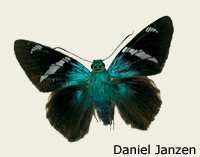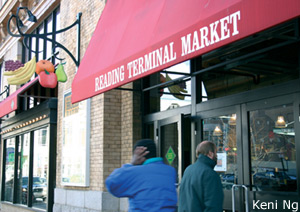| SAS Frontiers
Barcode of Life
 |
When taxonomists want to identify an animal, they look for
unique features that differentiate one species from another.
Those classification systems work fine for telling pigeons
from penguins, but for some closely related species, wing
color and beak shape are not enough. In 1775, traditional
taxonomists first described Astraptes fulgerator, a blue-and-brown
butterfly with a white band on each forewing. In 2004,
Dan Janzen, the Thomas E. and Louise G.
DiMaura Endowed Term Chair in Conservation Biology (together
with
taxonomist John Burns at the Smithsonian and evolutionary
biologist Paul Herbert at the University of Geulph) discovered
that this butterfly is really 10 distinct species. There
had long been doubts that A. fulgerator was a single species.
Although the adults look similar, the caterpillars have different
color patterns and prefer different food plants. The scientists
used a new technology that reads DNA sequences like a barcode,
focusing on a string of 645 genetic units in the cytochrome
c oxidase subunit
I gene, mitochondrial DNA possessed by all animals. Analysis
of 484 specimens revealed a variety of DNA barcodes within
A. fulgerator, indicating it was really a complex of hidden
species. Janzen and colleagues published their findings in
the “Proceedings of the National Academy of Sciences.” The
researchers concluded that significant differences in the
DNA sequence implied a long evolutionary separation among
the 10 species. “Barcoding is a tremendous tool,” Janzen
says. “Given the vast range – from Texas to Argentina – of
the supposed A. fulgerator single species, it doesn’t
take much imagination to realize that there are probably
a great many more hidden species out there.”
Reading
for Symbolism
Those who look to the culture we consume for big ideas, philosophical
or mystical, likely claim our oldest intellectual ancestry
in the Romantic period. But Peter Struck,
an assistant professor of classical studies, holds a different
view. “To the
extent that we look at fiction or poetry as a source of knowledge
about the basic structures of the world and the place of
humans in it … we are borrowing from the ancient allegorists.” Struck’s
recent book, Birth of the Symbol: Ancient Readers at
the Limits of Their Texts, re-envisions these ancient
writers. His view isn’t just new to general audiences,
who may never have heard of the late-Roman writer Proclus,
an interpreter
of Homer.
The book also represents a change for classicists, who generally
haven’t granted the
allegorists a place within the tradition of literary criticism
and thought of them as “foisting their own views onto
the text.” Tracing these misunderstood figures, Struck
examines a millennium’s worth of texts – from
early Greek literature to the Neoplatonists of Late Antiquity.
The allegorists, Struck says, “really
do push and push to see what they can find inside of Homer.
They want to see everything they can within those limits.” Whether
they stand at the edge of their texts or beyond it, he adds,
is open to case-by-case judgment. More interesting to examine
is why they thought their ideas were legitimate. “A
case study of these very enthusiastic interpreters gives
us a way of raising very broad questions about interpretation
in general.”
- Eileen Fisher
Sociology and the City
 |
Philadelphia’s Reading Terminal Market is an ideal
spot to grab a quick lunch or snag some Amish produce. But
when Elijah Anderson, the Charles and William
L. Day Distinguished Professor of Social Sciences, began
visiting the terminal,
he saw more than just a bazaar of eclectic restaurants, tchotchke
vendors and food kiosks. To him, the space was a curious
incubator of urban phenomena, racially, ethnically and socially
diverse. “In a city that we suppose is so riven with
race problems,” he says, “I was surprised to
find so much comity and goodwill there.” From the strangers
that would ask him for the score of 76ers games to the “white
man with white-supremacist friends [who] revealed his own
feelings about race and diversity,” Anderson was amazed
by how much people let their guard down. In “The Annals
of the American Academy of Political and Social Science” (vol.
595, no. 1) Anderson explains how places like the terminal
form “cosmopolitan canopies,” quasi-public spaces
where people approach strangers to talk, joke or even share
stories. In his research, Anderson
has documented other breeds of cosmopolitan canopies – from
upscale Philadelphia haunts like Rittenhouse Square and jazz
club Zanzibar Blue, to multicultural environs like off-track
betting parlors and hospital waiting rooms. The goal, he
says, is to form
a kind of “sociological theory of
life in urban culture,” an extension of his groundbreaking
inner-city ethnographies, Code of the Street (1999) and A
Place on the Corner (1981). Like W.E.B.
DuBois, Anderson doesn’t just want to study the African
American community inside neighborhood enclaves; he wants
to see how other races and ethnicities impact African Americans
outside the inner city.
-
Ted Mann |



